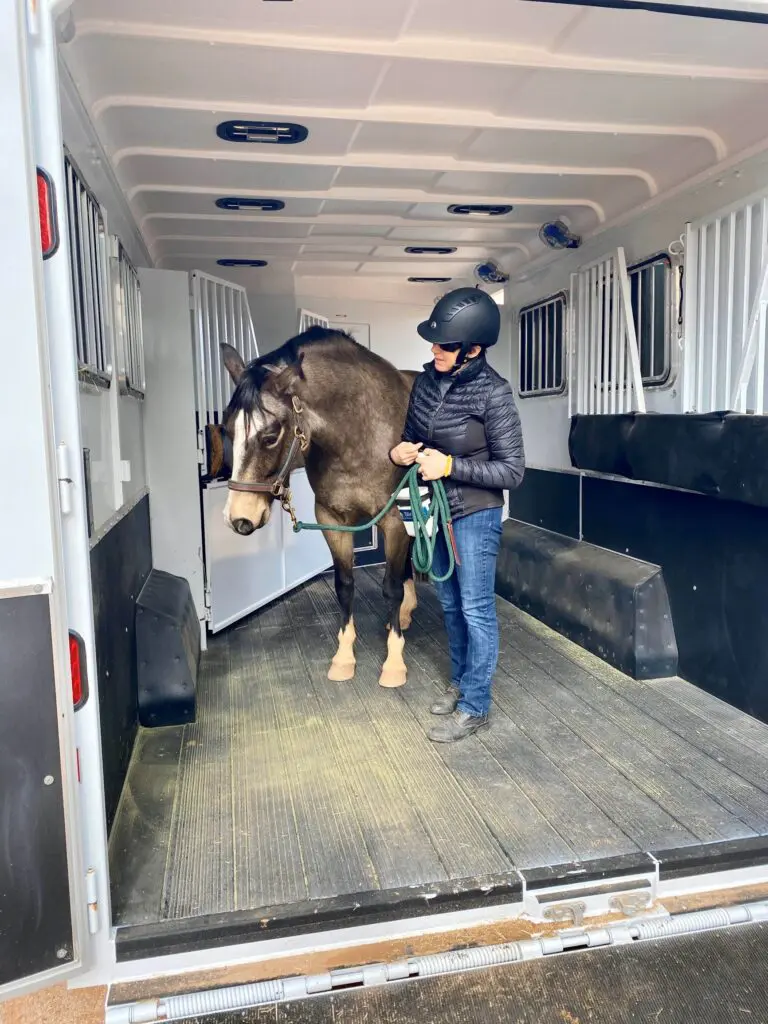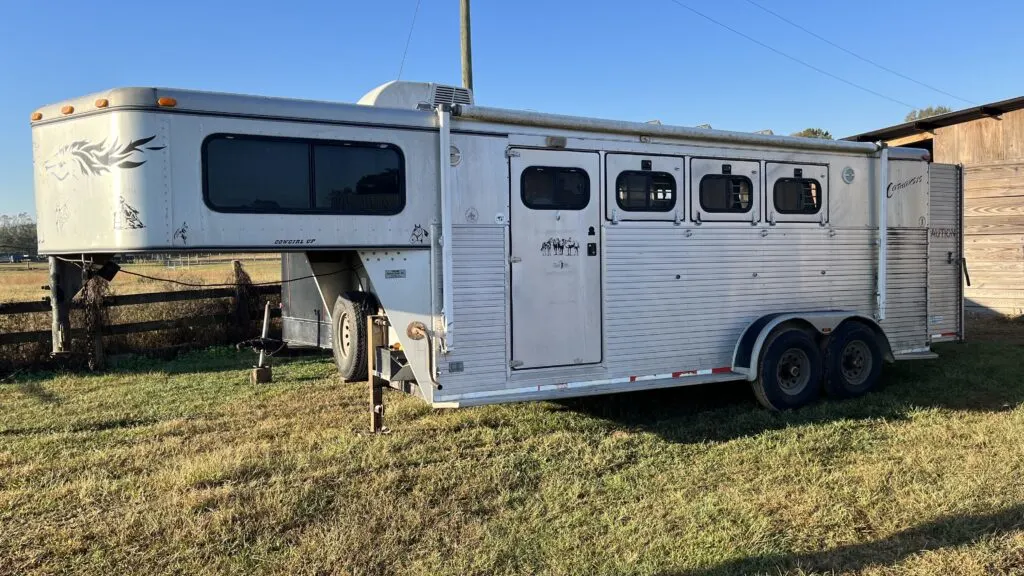Last updated: December 6, 2022
Any links on this page that lead to products on Amazon are affiliate links and I earn a commission if you make a purchase. Thanks in advance – I really appreciate it!
Guest Author: Brad Heath, DoubleDTrailers.com
The question of whether or not to tie your horse in the trailer has been debated for years. It’s a hot topic! Some owners faithfully leave their animals loose, so they can balance and move about as they wish. So, what’s the answer?
Answer:
There’s no definitive answer, as it depends on a number of factors, including the horse’s size, temperament, trailer design, and how many horses you’re hauling. However, in general, it’s a good idea to tie a horse when hauling to prevent it from moving around and injuring itself.
We’re going to take a look at the pros and cons of tying your horse while it’s traveling in a trailer. We’ll also take a moment to discuss safe haltering practices and discuss some unique trailer design features that will help keep your horse happy and safe while driving to an event.
Start with the Right Equipment.
To get things started, let’s make one thing very clear, different types of trailers and different horse personalities should impact your decision on whether or not to tie. Regardless, it would be best if you always used the proper safety equipment for your horse.

Essential equipment includes a safety or breakaway halter with leather or metal clips designed to snap under extreme tension. Popular and long-lasting nylon halters definitely do not fit the bill. These synthetic materials are so strong that a panicked horse is likely to injure himself long before the halter gives way.
If you choose to tie your horse, make sure you are using things like safety knots, quick-release ties, or even a simple piece of baling twine to secure the lead to the trailer loop. These precautions will let you free a horse who is struggling to save him from injury.
Finally, the hay provided for your horse needs to be tied in such a way that the animal can’t get his legs tangled in the bag. It’s also smart to always keep an equine first aid kit handy. Here is a good example of one.
So, assuming you have all of your equipment in order, let’s answer that all-important question, to tie or not to tie!

Pros of Tying Your Horse During Travel.
A properly tied horse will be given enough head slack so he can move his head and neck to balance while the trailer is in motion. He will also have enough slack to lower his head to sneeze out any particulate matter from his hay.
At the same time, his lead rope will be short enough that he cannot get his head stuck under the middle divider or loop a leg over the tie.
That sounds like a lot to manage! So, why bother?
The main pro for a well-tied horse is that they are prevented from moving around in the trailer and getting themselves into a pickle. We’ve heard many stories of small (and very large) horses trying to turn around within their trailer stall and getting stuck.
There have also been instances of animals getting their heads caught over or under the center divider and seriously injured or even killed. When tied, your horse won’t be able to reach around the head divider to nip at other horses.
Plus, the interior padding of your trailer will be protected from horses who like to chew when they’re bored. That will save you some dollars!
Instead, your horse will be secure in his stall and prevented from moving around, which may seem like a small thing for most horses, but any large breed owners understand how a horse kicking and moving can make your whole rig shudder and shake!
Cons of Tying Your Horse During Travel.
The opposing camp has horse owners who strongly feel not tying is the safer option. These folks point to the horse’s freedom as a way to keep them from getting trapped in the case of an accident. A tied horse inside an overturned trailer is more difficult to free than one who is loose.
Remember all those specifics about the correct length tie rope? Well, a horse that is not tied in a trailer doesn’t have to worry about looping his leg over the rope or being tied too tightly so that he cannot balance. Instead, he has complete control over his body.
Plus, a common problem occurs when owners open the back ramp of their trailer and forget to untie their horse before he is asked to back up. He starts to back, feels the tie on his face, and is likely to panic and scramble his feet. This problem is avoided when your horse is left loose.
Not tying your horse also allows them to position their bodies in the most comfortable orientation. In fact, many people with stock trailers have noted that their animals prefer to stand in a rear-facing direction while the trailer is in motion.
Researchers have found that horses have less stiffness and fatigue when they travel in the rear-facing direction. This problem can be solved by simply buying a reverse load trailer from a company like Double D Trailers.
These trailer models also have an extra rear divider so you can easily approach a horse’s head, safely clip on a lead line, and walk him off the trailer without having to back up.

How to Safely Tie Your Horse Outside the Trailer.
Once you arrive at your event, most horse owners will quickly tie their animals to those metal loops on the outside of the trailer. But is that the best idea?
If you look closely at the outside of your trailer, you’ll notice many different safety hazards. Your horse could easily injure himself or get his tie stuck on things like the spare wheel, a dressing room door, the edge of the tire well, or even the tire itself.
Let’s not forget to mention the damage that would be done to your trailer!
Still, many owners will continue to tie their horses to the outside of their trailers. Just remember to stick around and supervise. Don’t leave him for hours on end, or you won’t be able to help if he gets himself into a situation.
A safer set of alternatives would be to use high-tie options that move the horse farther away from the side of the trailer. These long bars stick out from the side of your trailer with a loop to secure your horse. Portable corral gates that can be transported on the side of your trailer also work well.
Should Horses Be Left In the Trailer Once You’ve Arrived?
Many horse owners like leaving their animals on the trailer when they arrive at a venue. They may open the side windows and let their horses get some fresh air while things are being set up.
Never leave a horse like this unobserved!
We’ve heard multiple stories of horses sticking their head out the window and deciding to launch the rest of their body out the window too. It’s a scary situation, for sure. A safer option would be to leave your horse’s window closed and fully unload them when you are ready.
Show-day trailer stalls, like those found on a 2+1 or the Double D Trailers SafeTack model, are useful so you can let your horse relax and move around more freely during a long day. Trailer stalls are also a great space to do final touch-ups on braids or keep your horse dry during a sudden downpour.
Again, this is a great convenience, but it should only be done while the horse is being watched.

The Double D Trailers SafeTack 3 Horse trailer is an attractive option to overcome many of the safety issues described above. It’s designed with either forward or rear-facing stalls, so your horses can travel in the most comfortable orientation.
Each animal has its own space with tubular head dividers for separation while still allowing light and airflow. These custom-sized stalls will let your animal balance during travel and avoid excessive fatigue.
Best of all, the SafeTack compartment in the rear corner swings out like a second door and allows for a full-width opening for more effortless loading and unloading onto this slant-load trailer. Horses are given a real “walk-on-walk-off” experience, which is much less scary and more manageable for horse owners.
Finally, that handy show day stall is the perfect way to let your horse relax while at an event. A large side loading ramp gives your horse easy access to load and unloads from this space. If you’d like to learn more about the SafeTack 3 Horse trailer, check out DoubleDTrailers.com.

Below is a helpful YouTube video discussing whether you should tie your horse in a trailer.
FAQ
How do you tie a horse in a straight-load trailer?
Let your horse enter and walk through the front of the trailers to tie a horse in a straight load. Once inside, attach a quick release to the trailer loop and your horse’s halter.
How to teach a horse to load in a trailer.
Work with your horse walking between two barrels, away from the trailer. Get him comfortable walking between close objects, and use pressure and release tactics.
Once he is comfortable, work slowly, have patience, and lead him into a trailer; let him take a few steps and take in his surroundings. As he advances, give him positive feedback and continue moving forward until he loads.
